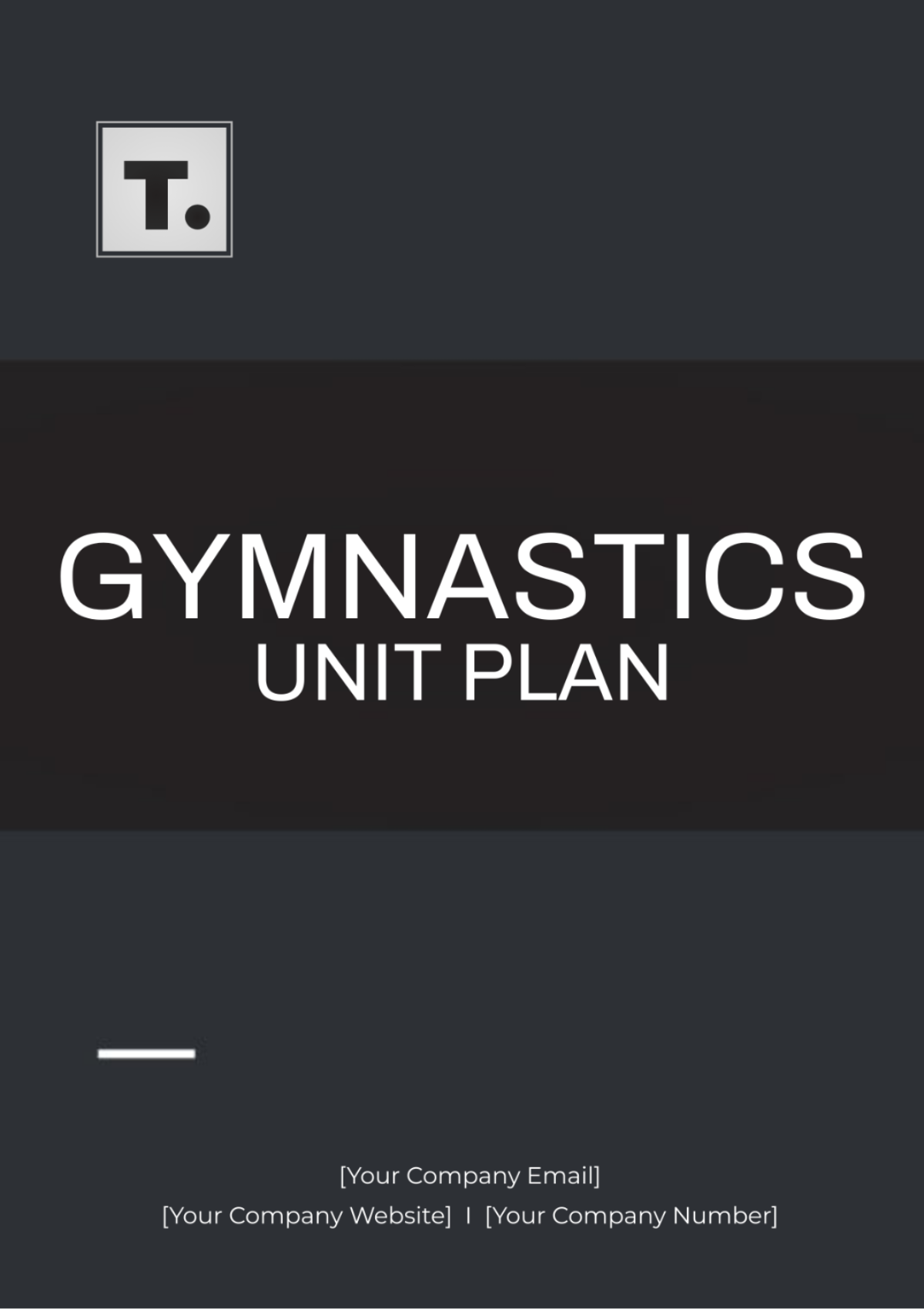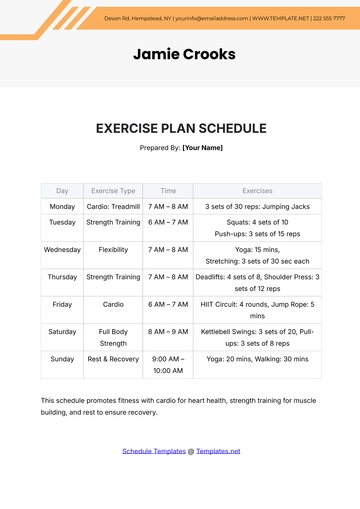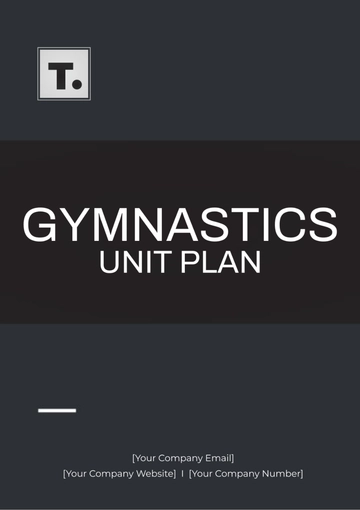Free Gymnastics Unit Plan

Prepared by: [Your Name]
I. Introduction
This Gymnastics Unit Plan is designed to guide the teaching and learning process of gymnastics over a 6-week period. It includes objectives, lesson plans, activities, assessments, and resources to ensure a comprehensive approach to teaching gymnastics skills and concepts. This plan aims to develop students' physical abilities, coordination, and confidence in performing gymnastics routines.
II. Objectives
Cognitive Objectives: Students will understand the basic rules, terminology, and safety procedures of gymnastics.
Psychomotor Objectives: Students will demonstrate proficiency in basic gymnastics skills such as rolls, handstands, cartwheels, and balance exercises.
Affective Objectives: Students will develop confidence, discipline, and teamwork through individual and group gymnastics activities.
III. Standards Alignment
This unit plan aligns with the National Standards for Physical Education, focusing on skill development, movement patterns, and personal and social responsibility.
IV. Lesson Plans
Week 1: Introduction and Safety
Objectives: Understand safety rules and warm-up exercises.
Activities: Introduction to gymnastics, safety briefing, basic warm-up routines.
Assessment: Observation of students' adherence to safety rules.
Week 2: Basic Movements
Objectives: Learn and practice forward rolls and backward rolls.
Activities: Demonstration and practice of rolls, peer feedback.
Assessment: Skill checklists and peer assessments.
Week 3: Balance and Coordination
Objectives: Develop balance through beam exercises and simple balance routines.
Activities: Beam walking, balance exercises on mats.
Assessment: Teacher observation and feedback.
Week 4: Handstands and Cartwheels
Objectives: Learn and practice handstands and cartwheels.
Activities: Progressions for handstands and cartwheels, individual practice.
Assessment: Formative assessment through skill performance.
Week 5: Combining Skills
Objectives: Combine previously learned skills into simple routines.
Activities: Practice routines that incorporate rolls, handstands, and balance.
Assessment: Peer and teacher assessments of routines.
Week 6: Performance and Evaluation
Objectives: Perform routines and reflect on personal progress.
Activities: Final performance of routines, group feedback sessions.
Assessment: Summative assessment based on performance criteria.
V. Skills and Techniques
Forward Roll: Tuck and roll technique, proper form.
Backward Roll: Safety in rolling backward, controlled movement.
Handstand: Alignment, balance, and control.
Cartwheel: Proper hand placement, leg positioning.
Balance: Techniques on beams and mats.
VI. Progressions
Rolling: Start with basic tuck rolls, progress to more advanced rolling techniques.
Handstands: Begin with wall-assisted handstands, move to free-standing.
Cartwheels: Start with supported cartwheels, advance to independent execution.
VII. Safety Guidelines
Always perform warm-up exercises before starting.
Use mats and spotters for all activities.
Follow teacher instructions carefully to avoid injuries.
Ensure a safe environment free of obstacles.
VIII. Assessment and Evaluation
Formative Assessments: Ongoing skill checklists, peer feedback, and teacher observations.
Summative Assessments: Final performance routines evaluated against set criteria.
IX. Resources
Equipment: Mats, balance beams, handstand blocks.
Materials: Instructional videos, safety guidelines posters, skill checklists.
Additional Resources: Online tutorials, gymnastics manuals, peer-reviewed articles on gymnastics education.
X. Differentiation Strategies
Beginner Level: Simplified exercises, additional support and guidance.
Intermediate Level: Standard exercises with minimal assistance.
Advanced Level: Complex routines, independent practice opportunities.
- 100% Customizable, free editor
- Access 1 Million+ Templates, photo’s & graphics
- Download or share as a template
- Click and replace photos, graphics, text, backgrounds
- Resize, crop, AI write & more
- Access advanced editor
Organize your gymnastics curriculum with Template.net's Gymnastics Unit Plan Template. This editable and customizable tool helps you outline objectives, activities, and assessments. Create detailed and structured unit plans. Editable in our AI Editor Tool, this template ensures comprehensive and professional unit planning, supporting effective gymnastics instruction and student development.
You may also like
- Finance Plan
- Construction Plan
- Sales Plan
- Development Plan
- Career Plan
- Budget Plan
- HR Plan
- Education Plan
- Transition Plan
- Work Plan
- Training Plan
- Communication Plan
- Operation Plan
- Health And Safety Plan
- Strategy Plan
- Professional Development Plan
- Advertising Plan
- Risk Management Plan
- Restaurant Plan
- School Plan
- Nursing Home Patient Care Plan
- Nursing Care Plan
- Plan Event
- Startup Plan
- Social Media Plan
- Staffing Plan
- Annual Plan
- Content Plan
- Payment Plan
- Implementation Plan
- Hotel Plan
- Workout Plan
- Accounting Plan
- Campaign Plan
- Essay Plan
- 30 60 90 Day Plan
- Research Plan
- Recruitment Plan
- 90 Day Plan
- Quarterly Plan
- Emergency Plan
- 5 Year Plan
- Gym Plan
- Personal Plan
- IT and Software Plan
- Treatment Plan
- Real Estate Plan
- Law Firm Plan
- Healthcare Plan
- Improvement Plan
- Media Plan
- 5 Year Business Plan
- Learning Plan
- Marketing Campaign Plan
- Travel Agency Plan
- Cleaning Services Plan
- Interior Design Plan
- Performance Plan
- PR Plan
- Birth Plan
- Life Plan
- SEO Plan
- Disaster Recovery Plan
- Continuity Plan
- Launch Plan
- Legal Plan
- Behavior Plan
- Performance Improvement Plan
- Salon Plan
- Security Plan
- Security Management Plan
- Employee Development Plan
- Quality Plan
- Service Improvement Plan
- Growth Plan
- Incident Response Plan
- Basketball Plan
- Emergency Action Plan
- Product Launch Plan
- Spa Plan
- Employee Training Plan
- Data Analysis Plan
- Employee Action Plan
- Territory Plan
- Audit Plan
- Classroom Plan
- Activity Plan
- Parenting Plan
- Care Plan
- Project Execution Plan
- Exercise Plan
- Internship Plan
- Software Development Plan
- Continuous Improvement Plan
- Leave Plan
- 90 Day Sales Plan
- Advertising Agency Plan
- Employee Transition Plan
- Smart Action Plan
- Workplace Safety Plan
- Behavior Change Plan
- Contingency Plan
- Continuity of Operations Plan
- Health Plan
- Quality Control Plan
- Self Plan
- Sports Development Plan
- Change Management Plan
- Ecommerce Plan
- Personal Financial Plan
- Process Improvement Plan
- 30-60-90 Day Sales Plan
- Crisis Management Plan
- Engagement Plan
- Execution Plan
- Pandemic Plan
- Quality Assurance Plan
- Service Continuity Plan
- Agile Project Plan
- Fundraising Plan
- Job Transition Plan
- Asset Maintenance Plan
- Maintenance Plan
- Software Test Plan
- Staff Training and Development Plan
- 3 Year Plan
- Brand Activation Plan
- Release Plan
- Resource Plan
- Risk Mitigation Plan
- Teacher Plan
- 30 60 90 Day Plan for New Manager
- Food Safety Plan
- Food Truck Plan
- Hiring Plan
- Quality Management Plan
- Wellness Plan
- Behavior Intervention Plan
- Bonus Plan
- Investment Plan
- Maternity Leave Plan
- Pandemic Response Plan
- Succession Planning
- Coaching Plan
- Configuration Management Plan
- Remote Work Plan
- Self Care Plan
- Teaching Plan
- 100-Day Plan
- HACCP Plan
- Student Plan
- Sustainability Plan
- 30 60 90 Day Plan for Interview
- Access Plan
- Site Specific Safety Plan

